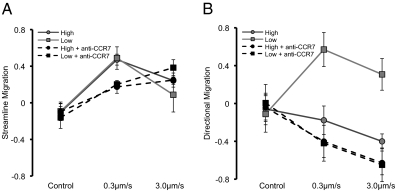Fig. 3.
Interstitial flow induces a bias in direction of tumor cell migration. “High” and “low” refer to seeding densities of 25 × 104 cells/mL and 5 × 104 cells/mL, respectively. (A) Streamline migration (see Fig. 2D for definition) measures the bias in migration along streamlines of a cell population. Cells exposed to interstitial flow preferentially migrated along streamlines, and this bias is a function of flow rate, cell density, and CCR7 receptor activity. Blocking CCR7 in a 0.3-μm/s flow field causes a significant decrease in streamline migration score (P < 0.01). In a 3.0-μm/s flow field, blocking CCR7 has the opposite effect of increasing streamline migration score, but only at a low cell density (P < 0.05). (B) Directional migration (see Fig. 2E for definition) demonstrates directional bias of cells migrating along the streamline, positive directional migration indicates downstream migration, and positive streamline migration indicates cells are preferentially migrating along the streamline. Cells exposed to interstitial flow preferentially migrated upstream or downstream as a function of flow rate, cell density, and CCR7 receptor activity. Directional migration scores become more negative with increasing flow velocity. With active CCR7, increasing cell density reverses directional bias from downstream to upstream (P < 0.01 for both flow rates), but when CCR7 is blocked, directional migration scores are more negative and do not depend on cell density. (Mean ± SD was computed by averaging the score for each cell in one device (n > 15) and averaging the score for three devices at each condition.)

